Screens and Preschools: The Bilingual English Language Learner Assessment as a Curriculum-Compliant Digital Application
Abstract
:1. Introduction
1.1. Digital Media and Early Development
1.2. Digital Media Classroom Learning and Curricula
2. Materials and Methods
2.1. Data Collection
2.2. Statistical Approach
3. Results
3.1. Sample Characteristics
3.2. Preliminary Exploration
3.2.1. Sex × Sub-Domain × Age
3.2.2. Age × Sub-Domain
3.2.3. Sex × Sub-Domain
3.2.4. Summary of ANOVAs
3.3. Mixed Models’ Results
4. Discussion
5. Limitations and Future Directions
6. Conclusions
Author Contributions
Funding
Institutional Review Board Statement
Informed Consent Statement
Data Availability Statement
Acknowledgments
Conflicts of Interest
References
- Griffith, S.F.; Hagan, M.B.; Heymann, P.; Heflin, B.H.; Bagner, D.M. Apps As Learning Tools: A Systematic Review. Pediatrics 2020, 145, e20191579. [Google Scholar] [CrossRef] [PubMed]
- Hill, D.; Ameenuddin, N.; Reid Chassiakos, Y.; Cross, C.; Hutchinson, J.; Levine, A.; Boyd, R.; Mendelson, R.; Moreno, M.; Swanson, W.S. Media and Young Minds. Pediatrics 2016, 138, e20162591. [Google Scholar] [CrossRef]
- Kucirkova, N. IPads in early education: Separating assumptions and evidence. Front. Psychol. 2014, 5, 715. [Google Scholar] [CrossRef] [PubMed]
- Tan, M.; Kilani, H.; Markov, I.; Hein, S.; Grigorenko, E.L. Assessing Cognitive Skills in Early Childhood Education Using a Bilingual Early Language Learner Assessment Tool. J. Intell. 2023, 11, 143. [Google Scholar] [CrossRef] [PubMed]
- Alotaibi, M.S. Game-based learning in early childhood education: A systematic review and meta-analysis. Front. Psychol. 2024, 15, 1307881. [Google Scholar] [CrossRef] [PubMed]
- Zhu, S.; Guo, Q.; Yang, H.H. Digital Game-Based Assessment on Student Evaluation: A Systematic Review. In Proceedings of the International Conference on Blended Learning, Bangkok, Thailand, 24–27 August 2022; pp. 85–96. [Google Scholar]
- Puolakanaho, A.; Latvala, J.-M. Embedding preschool assessment methods into digital learning games to predict early reading skills. Hum. Technol. 2017, 13, 216–236. [Google Scholar] [CrossRef]
- Marisa, M.; Jennifer, M.Z.; Jennifer, M.Z.; Caroline, M.; Caroline, M.; Michael, R.; Michael, R.; Michael, B.R.; Harlan, M.; Harlan, M.; et al. How educational are “educational” apps for young children? App store content analysis using the Four Pillars of Learning framework. J. Child. Media 2021, 15, 526–548. [Google Scholar] [CrossRef]
- Stamatios, P.; Michail, K.; Michail, K.; Nicholas, Z.; Nicholas, Z. Designing and creating an educational app rubric for preschool teachers. Educ. Inf. Technol. 2017, 22, 3147–3165. [Google Scholar] [CrossRef]
- Zaranis, N.; Nicholas, Z.; Michail, K.; Michail, K.; Stamatios, P. Using Mobile Devices for Teaching Realistic Mathematics in Kindergarten Education. Creat. Educ. 2013, 4, 1–10. [Google Scholar] [CrossRef]
- Kathy, H.-P.; Jennifer, M.Z.; Jennifer, M.Z.; Roberta Michnick, G.; James, H.G.; Michael, B.R.; Jordy, K. Putting Education in “Educational” Apps Lessons From the Science of Learning. Psychol. Sci. Public Interest 2015, 16, 3–34. [Google Scholar] [CrossRef]
- Vaiopoulou, J.; Papadakis, S.; Sifaki, E.; Kalogiannakis, M.; Stamovlasis, D. Classification and evaluation of educational apps for early childhood: Security matters. Educ. Inf. Technol. 2023, 28, 2547–2578. [Google Scholar] [CrossRef] [PubMed]
- Gulliford, A.; Walton, J.M.; Walton, J.; Allison, K.; Pitchford, N.J. A Qualitative Investigation of Implementation of App-Based Maths Instruction for Young Learners. Educ. Child Psychol. 2021, 38, 90–108. [Google Scholar] [CrossRef]
- Meyer, M.; Adkins, V.; Yuan, N.; Weeks, H.M.; Chang, Y.-J.; Radesky, J. Advertising in young children’s apps: A content analysis. J. Dev. Behav. Pediatr. 2019, 40, 32–39. [Google Scholar] [CrossRef] [PubMed]
- Council on Communications and Media. Media and young minds. Pediatrics 2016, 138, e20162591. [Google Scholar] [CrossRef] [PubMed]
- Opfer, J.E.; Siegler, R.S. Representational change and children’s numerical estimation. Cogn. Psychol 2007, 55, 169–195. [Google Scholar] [CrossRef] [PubMed]
- Pan, Q.; Trang, K.T.; Love, H.R.; Templin, J. School readiness profiles and growth in academic achievement. Front. Educ. 2019, 4, 1–17. [Google Scholar] [CrossRef]
- Yun, C.; Melnick, H.; Wechsler, M. High-Quality Early Childhood Assessment: Learning from States’ Use of Kindergarten Entry Assessments; Learning Policy Institute: Palo Alto, CA, USA, 2021. [Google Scholar]
- Unicef, I. Comprehensive Life Skills Framework; UNICEF: New Delhi, India, 2019. [Google Scholar]
- Laura, A.O.; Marc, F.; Anthea, G.; Nicola, J.P. Raising early achievement in math with interactive apps: A randomized control trial. J. Educ. Psychol. 2019, 111, 284–298. [Google Scholar] [CrossRef]
- Wang, Z.; Goonewardene, L.A. The use of MIXED models in the analysis of animal experiments with repeated measures data. Can. J. Anim. Sci. 2004, 84, 1–11. [Google Scholar] [CrossRef]
- Cnaan, A.; Laird, N.M.; Slasor, P. Using the general linear mixed model to analyse unbalanced repeated measures and longitudinal data. Stat. Med. 1997, 16, 2349–2380. [Google Scholar] [CrossRef]
- Littell, R.C.; Henry, P.; Ammerman, C.B. Statistical analysis of repeated measures data using SAS procedures. J. Anim. Sci. 1998, 76, 1216–1231. [Google Scholar] [CrossRef]
- Bono Cabré, R.; Alarcón-Postigo, R.; Blanca-Mena, M.J. Report Quality of Generalized Linear Mixed Models in Psychology: A Systematic Review. Front. Psychol. 2021, 12, 666182. [Google Scholar]
- Barr, R.; Kirkorian, H.L. Reexamining models of early learning in the digital age: Applications for learning in the wild. J. Appl. Res. Mem. Cogn. 2023, 12, 457–472. [Google Scholar] [CrossRef] [PubMed]

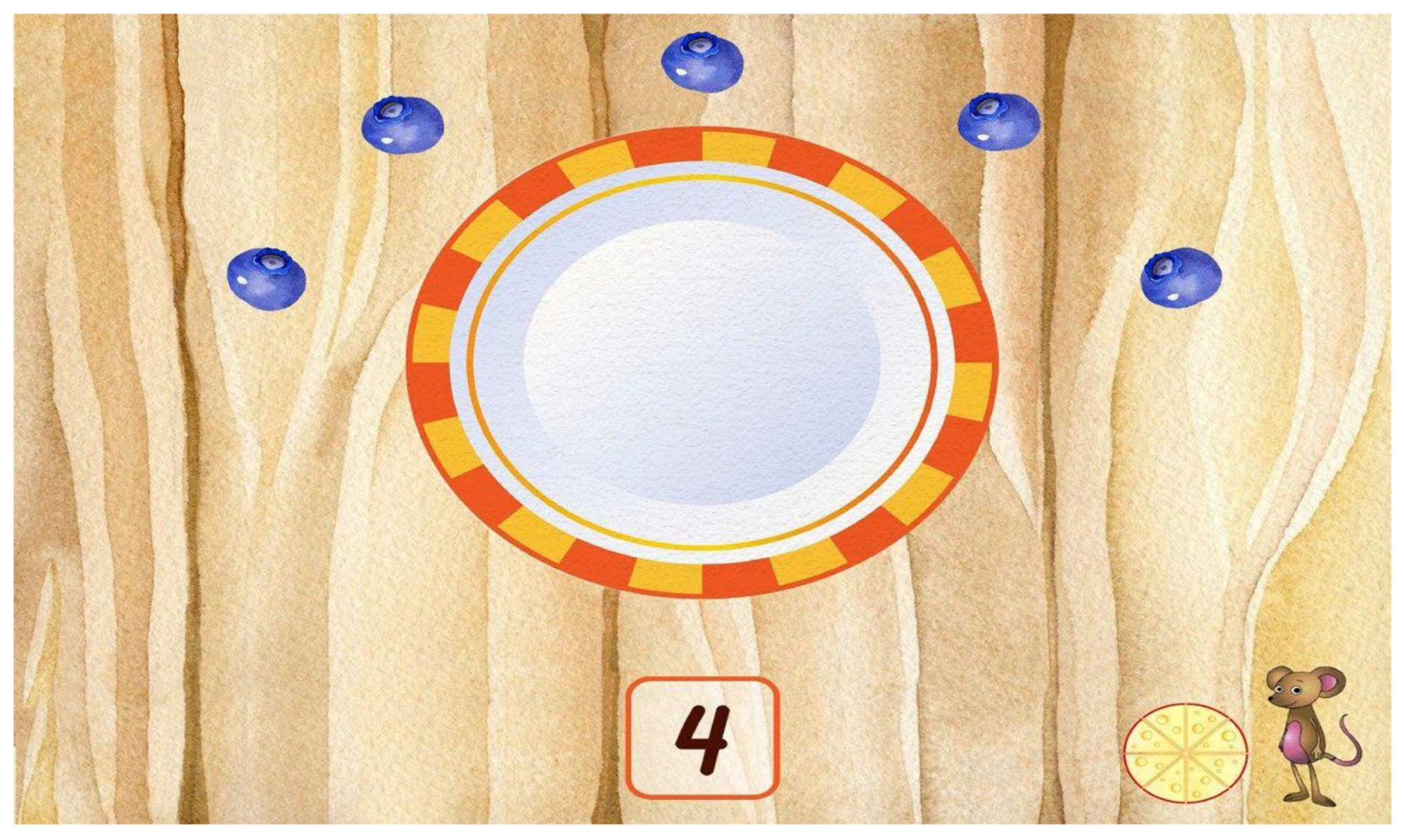
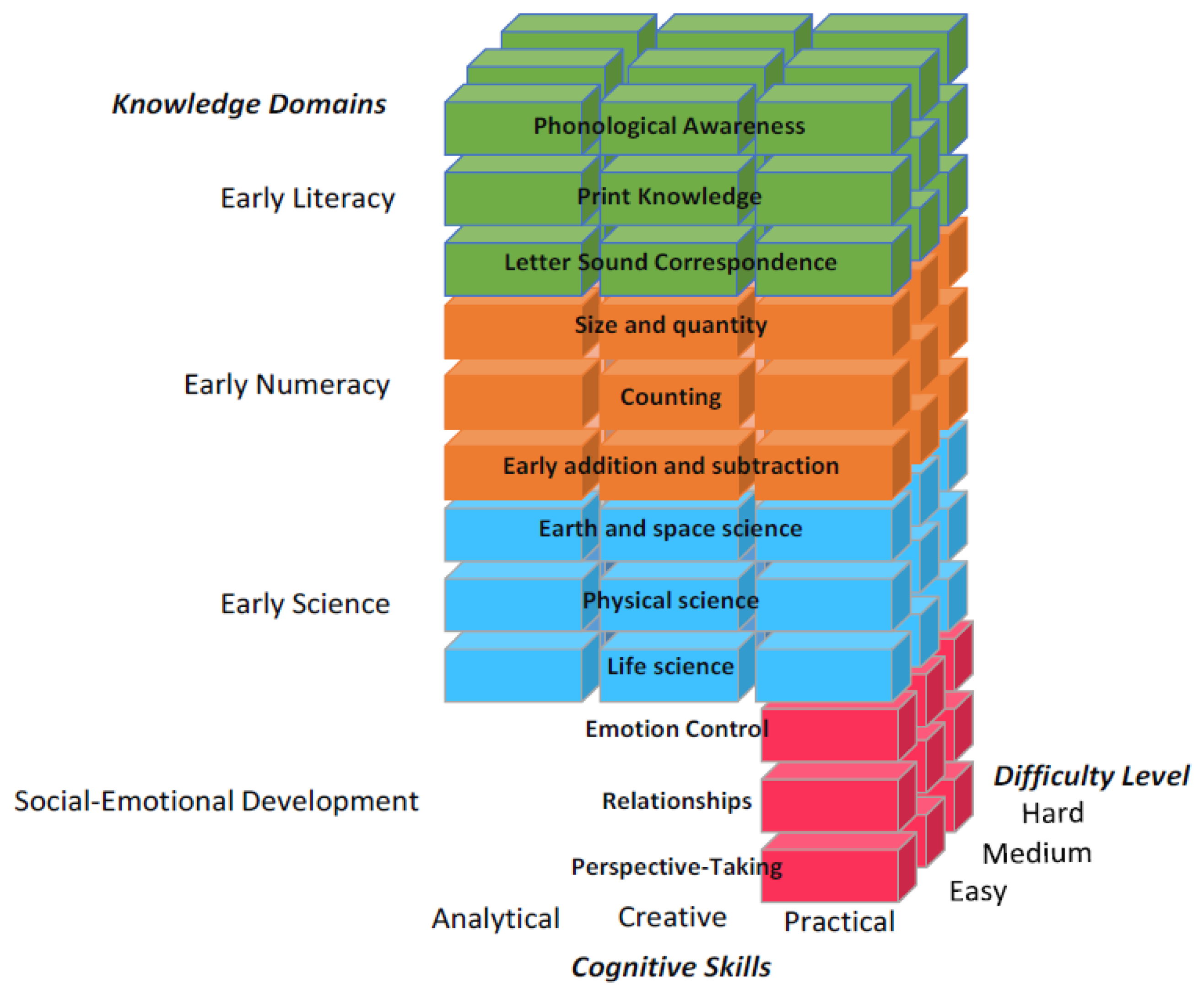
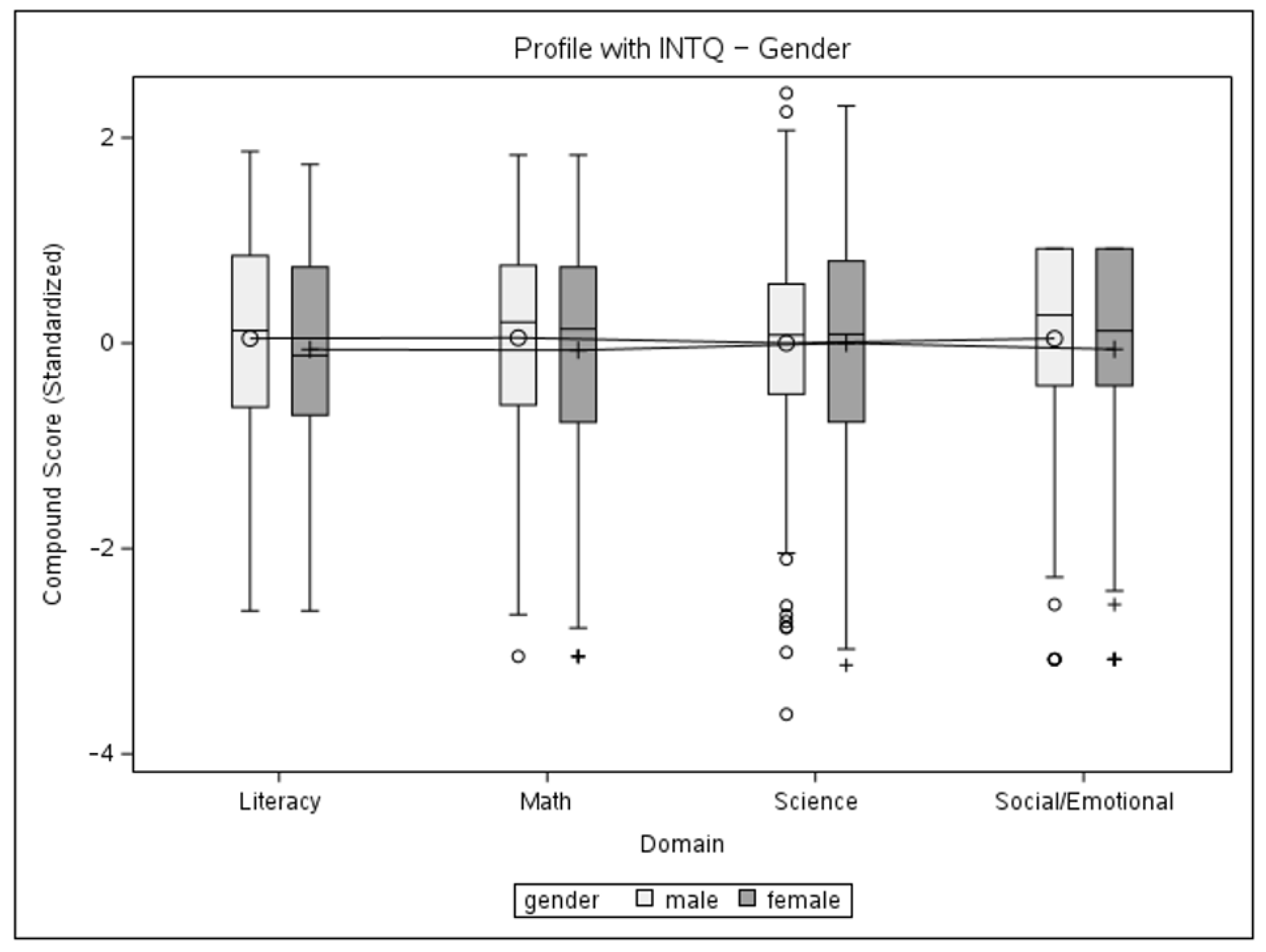
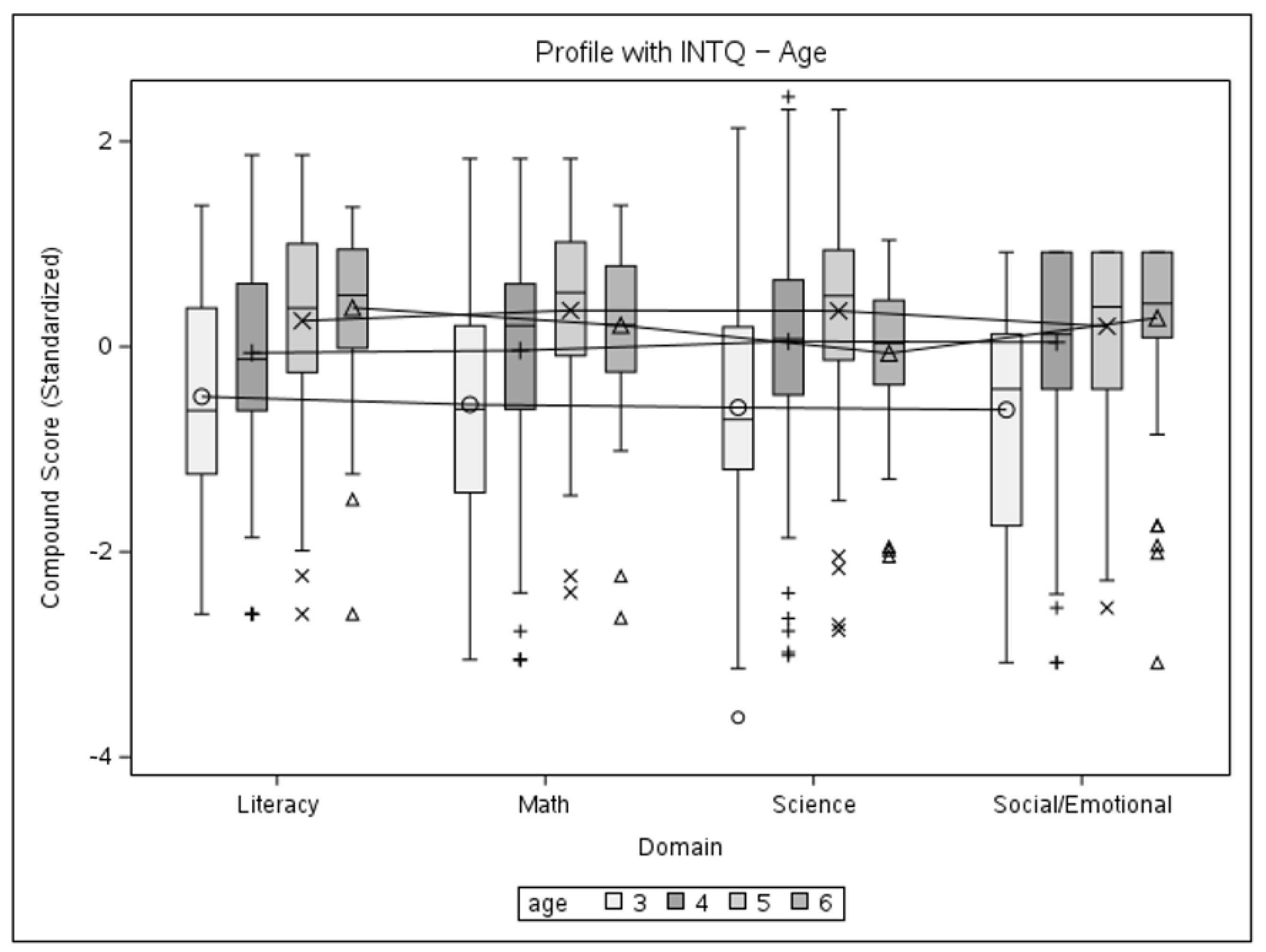
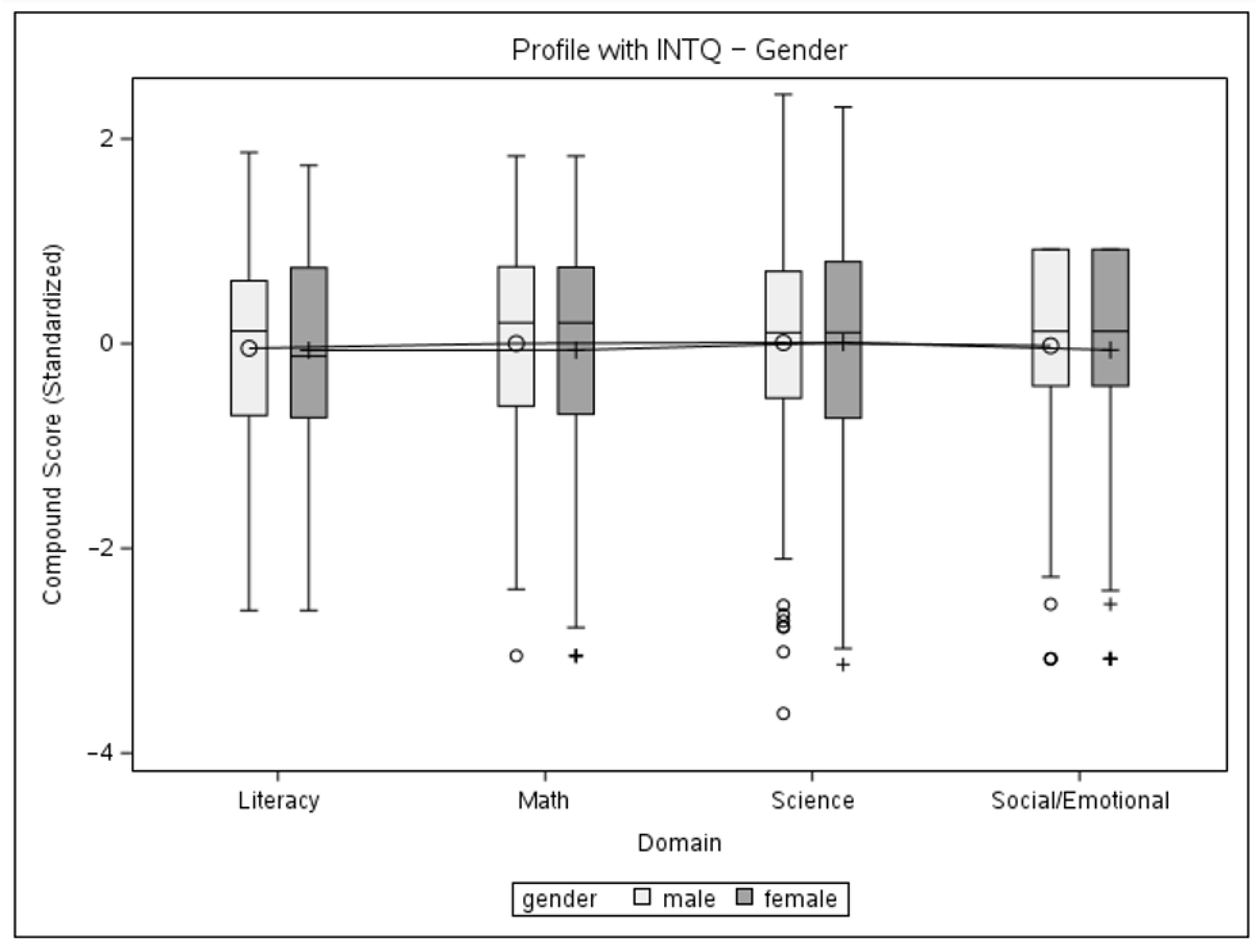
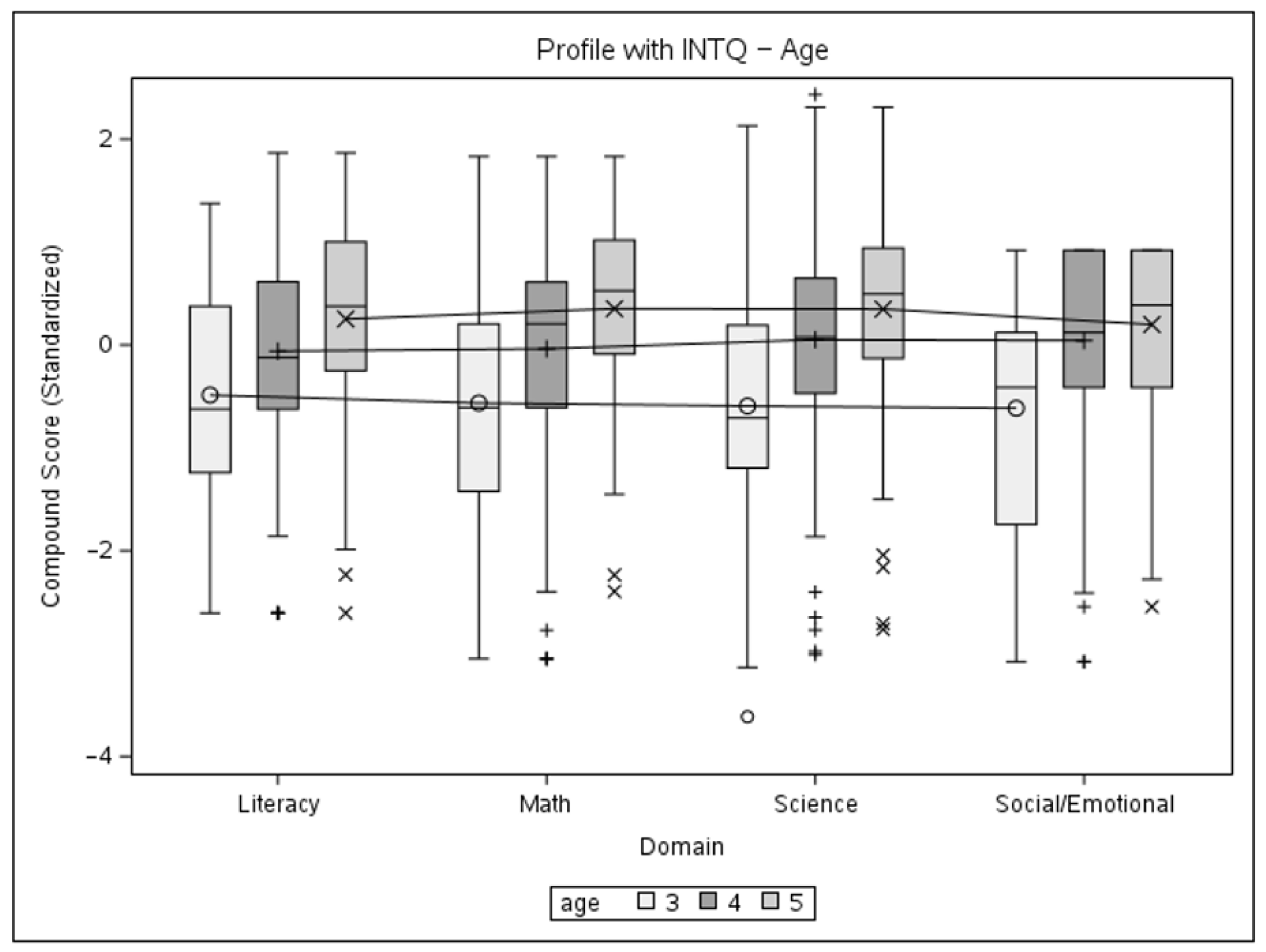
| Analysis Variable: Pass Rate | ||||
|---|---|---|---|---|
| Age | Sex | N | Mean | Std Dev |
| 3 | female | 45 | 53.6773 | 17.9981 |
| male | 40 | 51.7828 | 14.4356 | |
| 4 | female | 119 | 63.3162 | 14.5783 |
| male | 114 | 63.7005 | 12.4611 | |
| 5 | female | 52 | 69.4444 | 12.0181 |
| male | 71 | 68.8912 | 14.409 | |
| 6 | female | 2 | 54.2576 | 2.12132 |
| male | 63 | 65.7999 | 11.2099 | |
| Analysis Variable: Pass Rate | ||||
|---|---|---|---|---|
| Sub-Domain | Age | N | Mean | Variance |
| Counting | 3 | 69 | 49.9217 | 1307.26 |
| 4 | 202 | 64.1788 | 920.61 | |
| 5 | 113 | 71.0167 | 848.674 | |
| 6 | 62 | 59.4594 | 508.845 | |
| Early Addition and Subtraction | 3 | 85 | 44.651 | 1010.53 |
| 4 | 233 | 50.9922 | 1088.15 | |
| 5 | 123 | 59.7793 | 854.07 | |
| 6 | 65 | 57.1026 | 558.605 | |
| Earth and Space Science | 3 | 85 | 55.0993 | 550.643 |
| 4 | 233 | 67.3418 | 405.841 | |
| 5 | 123 | 70.6373 | 280.649 | |
| 6 | 65 | 61.9641 | 135.609 | |
| Emotional Control; Emotion Recognition | 3 | 59 | 74.5763 | 1928.7 |
| 4 | 170 | 67.5294 | 2011.32 | |
| 5 | 103 | 80.0647 | 1463.99 | |
| 6 | 61 | 89.8907 | 724.803 | |
| Empathy | 3 | 73 | 55.4338 | 1818.98 |
| 4 | 208 | 76.5854 | 1142.87 | |
| 5 | 118 | 77.0682 | 1145.47 | |
| 6 | 64 | 78.3333 | 1006.53 | |
| Letter/Sound Corres. | 3 | 70 | 50.3429 | 900.049 |
| 4 | 203 | 62.1149 | 645.804 | |
| 5 | 113 | 70.8098 | 535.11 | |
| 6 | 62 | 84.0118 | 326.548 | |
| Life Science | 3 | 85 | 47.2902 | 448.169 |
| 4 | 233 | 53.9798 | 341.19 | |
| 5 | 123 | 61.8297 | 271.126 | |
| 6 | 65 | 59.065 | 163.66 | |
| Phonological Awareness | 3 | 59 | 34.6017 | 679.61 |
| 4 | 170 | 47.5624 | 694.334 | |
| 5 | 103 | 53.2737 | 745.158 | |
| 6 | 61 | 44.515 | 541.652 | |
| Physical Science | 3 | 85 | 58.6085 | 578.198 |
| 4 | 233 | 69.2574 | 295.213 | |
| 5 | 123 | 71.7937 | 352.835 | |
| 6 | 65 | 64.2509 | 156.535 | |
| Print Knowledge | 3 | 85 | 52.4353 | 1565.07 |
| 4 | 233 | 60.8774 | 1184.71 | |
| 5 | 123 | 68.1721 | 930.227 | |
| 6 | 65 | 71.4192 | 673.376 | |
| Relationships; Emotional Control | 3 | 85 | 61.4706 | 1603.8 |
| 4 | 233 | 82.5603 | 917.626 | |
| 5 | 123 | 87.6039 | 623.72 | |
| 6 | 65 | 83.8462 | 603.379 | |
| Size and Quantity | 3 | 68 | 65.288 | 790.269 |
| 4 | 194 | 72.3288 | 628.153 | |
| 5 | 96 | 80.9239 | 392.449 | |
| 6 | 60 | 82.7292 | 243.988 | |
| Analysis Variable: Pass Rate | |||||
|---|---|---|---|---|---|
| Cognitive Skill | Age | N | Mean | Variance | Std Dev |
| Analytical | 3 | 85 | 54.3529 | 479.504 | 21.8976 |
| 4 | 233 | 66.6527 | 271.325 | 16.472 | |
| 5 | 123 | 73.8463 | 248.543 | 15.7652 | |
| 6 | 65 | 75.2179 | 215.457 | 14.6785 | |
| Creative | 3 | 85 | 44.9531 | 273.975 | 16.5522 |
| 4 | 233 | 54.3781 | 239.614 | 15.4795 | |
| 5 | 123 | 59.4256 | 276.64 | 16.6325 | |
| 6 | 65 | 42.0446 | 70.6016 | 8.40248 | |
| Practical | 3 | 85 | 57.5566 | 348.652 | 18.6722 |
| 4 | 233 | 68.0166 | 250.741 | 15.8348 | |
| 5 | 123 | 72.8625 | 226.715 | 15.0571 | |
| 6 | 65 | 75.927 | 209.233 | 14.4649 | |
| Solution for Fixed Effects | Fit Statistics | ||||
|---|---|---|---|---|---|
| Gender * Domain—Unstructured | |||||
| Effect | Num DF | Den DF | F Value | p | −2 Res Log Likelihood |
| Domain | 3 | 1512 | 0.02 | 0.9974 | AIC |
| Gender | 1 | 504 | 1.45 | 0.2284 | AICC |
| Gender * Domain | 3 | 1512 | 0.8 | 0.4951 | BIC |
| Age * Domain—Unstructured | |||||
| Effect | Num DF | Den DF | F Value | p | −2 Res Log Likelihood |
| Domain | 3 | 1506 | 1.08 | 0.3563 | AIC |
| Age | 3 | 502 | 22.44 | <0.0001 | AICC |
| Age * Domain | 9 | 1506 | 5.9 | <0.0001 | BIC |
| Age * Domain—Compound Symmetry | |||||
| Effect | Num DF | Den DF | F Value | p | −2 Res Log Likelihood |
| Domain | 3 | 1506 | 0.99 | 0.3972 | AIC |
| Contrast Levels | Estimate | Standard Error | DF | t Value | p |
|---|---|---|---|---|---|
| Lit −3 + 4 vs. 5 + 6 | −1.1784 | 0.187 | 1506 | −6.3 | <0.0001 * |
| Math −3 + 4 vs. 5 + 6 | −1.1622 | 0.187 | 1506 | −6.21 | <0.0001 * |
| Science −3 + 4 vs. 5 + 6 | −0.8264 | 0.187 | 1506 | −4.42 | <0.0001 * |
| Soc/Em −3 + 4 vs. 5 + 6 | −1.0519 | 0.187 | 1506 | −5.62 | <0.0001 * |
| Lit −3 + 4 vs. 5 | −1.0512 | 0.2134 | 1506 | −4.92 | <0.0001 * |
| Math −3 + 4 vs. 5 | −1.3072 | 0.2134 | 1506 | −6.12 | <0.0001 * |
| Science −3 + 4 vs. 5 | −1.2393 | 0.2134 | 1506 | −5.81 | <0.0001 * |
| Soc/Em −3 + 4 vs. 5 | −0.9701 | 0.2134 | 1506 | −4.55 | <0.0001 * |
| Lit −3 + 4 + 5 vs. 6 | −1.4328 | 0.3242 | 1506 | −4.42 | <0.0001 * |
| Math −3 + 4 + 5 vs. 6 | −0.8722 | 0.3242 | 1506 | −2.69 | 0.0072 |
| Science −3 + 4 + 5 vs. 6 | −0.0007 | 0.3242 | 1506 | 0 | 0.9984 |
| Soc/Em −3 + 4 + 5 vs. 6 | −1.2153 | 0.3242 | 1506 | −3.75 | 0.0002 |
| Solution for Fixed Effects | Fit Statistics | |||||
|---|---|---|---|---|---|---|
| Gender * Domain—Unstructured | ||||||
| Effect | Num DF | Den DF | F Value | p | −2 Res Log Likelihood | 4710.1 |
| Domain | 3 | 1317 | 0.63 | 0.5926 | AIC | 4750.1 |
| Sex | 1 | 439 | 0.18 | 0.6711 | AICC | 4750.5 |
| Sex * Domain | 3 | 1317 | 0.17 | 0.9183 | BIC | 4831.8 |
| Age * Domain—Unstructured | ||||||
| Effect | Num DF | Den DF | F Value | p | −2 Res Log Likelihood | 4599.7 |
| Domain | 3 | 1314 | 0.35 | 0.7912 | AIC | 4659.7 |
| Age | 2 | 438 | 30.96 | <0.0001 | AICC | 4660.8 |
| Age * Domain | 6 | 1314 | 1.16 | 0.3268 | BIC | 4782.4 |
| Age * Domain—Compound Symmetry | ||||||
| Effect | Num DF | Den DF | F Value | p | −2 Res Log Likelihood | 4686.8 |
| Domain | 3 | 1314 | 0.4 | 0.7523 | AIC | 4690.8 |
| Age | 2 | 438 | 35.6 | <0.0001 | AICC | 4690.8 |
| Age * Domain | 6 | 1314 | 1.12 | 0.3473 | BIC | 4699 |
| Age | Estimate | Standard Error | DF | t Value | p |
|---|---|---|---|---|---|
| 3 | −0.5654 | 0.07815 | 438 | −7.24 | <0.0001 |
| 4 | −0.0014 | 0.0472 | 438 | −0.03 | 0.9759 |
| 5 | 0.2876 | 0.06496 | 438 | 4.43 | <0.0001 |
Disclaimer/Publisher’s Note: The statements, opinions and data contained in all publications are solely those of the individual author(s) and contributor(s) and not of MDPI and/or the editor(s). MDPI and/or the editor(s) disclaim responsibility for any injury to people or property resulting from any ideas, methods, instructions or products referred to in the content. |
© 2024 by the authors. Licensee MDPI, Basel, Switzerland. This article is an open access article distributed under the terms and conditions of the Creative Commons Attribution (CC BY) license (https://creativecommons.org/licenses/by/4.0/).
Share and Cite
Kilani, H.; Markov, I.V.; Francis, D.; Grigorenko, E.L. Screens and Preschools: The Bilingual English Language Learner Assessment as a Curriculum-Compliant Digital Application. Children 2024, 11, 914. https://doi.org/10.3390/children11080914
Kilani H, Markov IV, Francis D, Grigorenko EL. Screens and Preschools: The Bilingual English Language Learner Assessment as a Curriculum-Compliant Digital Application. Children. 2024; 11(8):914. https://doi.org/10.3390/children11080914
Chicago/Turabian StyleKilani, Hechmi, Ilia V. Markov, David Francis, and Elena L. Grigorenko. 2024. "Screens and Preschools: The Bilingual English Language Learner Assessment as a Curriculum-Compliant Digital Application" Children 11, no. 8: 914. https://doi.org/10.3390/children11080914





